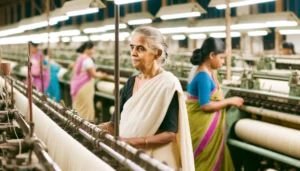In the realm of fashion, wholesale clothing manufacturing serves as the backbone of the industry, supplying retailers and brands with a steady stream of garments to meet consumer demand. For those considering venturing into wholesale clothing manufacturing, understanding the intricacies of the process and choosing the right location are crucial steps.
In this comprehensive guide, we’ll explore how wholesale clothing manufacturing works, how to set it up in India, and the advantages of choosing India over the United States as the destination for this endeavor.

How Wholesale Clothing Manufacturing Works?
Wholesale clothing manufacturing involves large-scale production of garments to be sold in bulk to retailers, distributors, and brands. The process typically begins with designing and prototyping, followed by sourcing raw materials, production, quality control, and packaging.
Manufacturers cater to a diverse range of clients, producing everything from basic apparel staples to high-fashion garments and accessories. By producing garments in large quantities, wholesale manufacturers can achieve economies of scale, driving down production costs and offering competitive pricing to their clients.
Setting Up Wholesale Clothing Manufacturing in India
Market Research: Conduct thorough market research to identify niche segments, target demographics, and competitive landscape in the wholesale clothing market. Determine the type of garments you want to produce and the specific needs of your target clients.
Business Plan: Develop a comprehensive business plan outlining your objectives, target market, product offerings, pricing strategy, and marketing approach. Define your manufacturing process, supply chain management, and operational requirements.
Legal and Regulatory Compliance: Register your business and obtain the necessary licenses and permits required for clothing manufacturing. Ensure compliance with labor laws, environmental regulations, and other statutory requirements.
Infrastructure and Equipment: Set up a production facility equipped with cutting-edge machinery, tools, and equipment necessary for garment manufacturing. Invest in technology solutions for design, pattern-making, and production management.
Supply Chain Management: Establish relationships with reliable suppliers and vendors for sourcing raw materials, fabrics, and accessories. Implement efficient inventory management systems to optimize supply chain operations.
Skilled Workforce: Recruit and train a team of skilled workers, including pattern makers, cutters, seamstresses, and quality control inspectors. Provide ongoing training and development to enhance their skills and productivity.
Marketing and Branding: Develop a strong brand identity and marketing strategy to promote your wholesale clothing business. Utilize online and offline channels such as websites, social media, trade shows, and collaborations to reach your target audience.
Advantages of Setting Up Wholesale Clothing Manufacturing in India

Cost-Effectiveness: India offers lower labor and production costs compared to the United States, making it more cost-effective to manufacture clothing in India. This enables manufacturers to produce garments at competitive prices, maximizing profit margins.
Skilled Workforce: India boasts a skilled workforce with expertise in various aspects of garment manufacturing, ensuring superior quality and attention to detail in every garment produced.
Vertical Integration: India’s vertically integrated textile industry provides a seamless supply chain for clothing manufacturing, reducing lead times and enhancing efficiency.
Diverse Fabric Options: India offers a wide variety of fabrics, from traditional handlooms to modern textiles, providing endless possibilities for customization and creativity.
Strategic Location and Access to Global Markets: India’s strategic location in South Asia provides easy access to key global markets, enabling manufacturers to export garments internationally and benefit from reduced tariffs and trade barriers.
In conclusion, setting up wholesale clothing manufacturing in India offers numerous advantages, including cost-effectiveness, skilled workforce, vertical integration, diverse fabric options, and strategic location.
By leveraging these advantages, manufacturers can establish successful and sustainable businesses, catering to the diverse needs of clients worldwide. With its unmatched expertise, efficiency, and affordability, India emerges as the right destination for wholesale clothing manufacturing in the United States.
